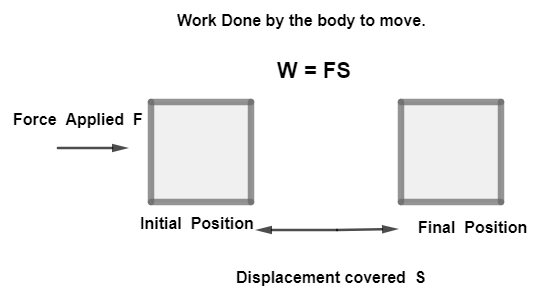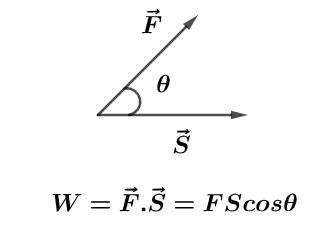Work -Definition, Formula, Examples, FAQs
What is Work?
The term work in everyday life is used to indicate that whenever an activity is done physically we simply say that the body has done some work. When a body moves from its initial position to some distance we simply say this activity of a body as work done by the body.
What is work done in Physics?
In physics, Work done is simply the amount of energy a body needs to move it from its initial position to the final position.
Work Done Definition:
The standard work done definition states that “ The work done by a body is equal to the dot product between the force applied on the body and displacement covered by the body”.
Also read -
- NCERT Solutions for Class 11 Physics
- NCERT Solutions for Class 12 Physics
- NCERT Solutions for All Subjects
Work Done Formula:
If a body is applied by some amount of force F and the body covers some displacement S then the work done by the body is written mathematically as W=F.S where W is denoted for work done.

(Source: Self-Drawn Using Geogebra)
S.I Unit and Dimensional formula of work done.
Mathematically, work done is the product of the force applied on the body and displacement covered by it, and since force has a SI unit of Kgms-2 and displacement has a SI unit of m so, work done will have a SI unit of Kgm2s-2 and standard notation for SI unit of Work done is known as Joules which is denoted as J and it was named after by scientist James Joules.
So, The SI unit of work done is Joules and the dimensional formula of work done is ML2T-2
Meaning of work definition Physics
Consider a block lying horizontally on the table and now it’s affected by some amount of applied force in a particular direction F and let this block gets moved to some displacement in specific direction S and the angle between the force vector and the displacement vector be then the work done by the body in order to cover this displacement is defined as W=F.S and since it’s the dot product between force vector and displacement vector so, Work done is written as W=FScos

(Source: Self Drawn using Geogebra)
Hence, the meaning of work done is simply that, the amount of work done by a body in order to cover a displacement of S when applied with some force of magnitude F and having an angle between force and displacement vector is calculated as W=FScos
Various Factors on which Work done by a body depends.
Some of the factors which affect the work done by a body are listed as:
- Force. So, Work done on a body depends upon force and it’s directly proportional to the force acting on a body. On increasing the magnitude of force, the magnitude of work done is also gets increased while On decreasing the magnitude of force, the work done by a body also gets decreased.
- Displacement. Work done by a body depends upon displacement and it’s directly proportional to the displacement covered by the body. When a body covers greater displacement the work done by the body is also greater while when the body covers less displacement, the work done by the body is also very less.
Related Topics Link, |
Variation of work done by a body on varying the value of “Angle between Force and Displacement vector”
Since Work done is directly proportional to the cosine of the angle between force vector and displacement vector which can be seen from the work done formula as W=FScos and we know that decreases while going from zero to degree ninety. So, the value of work done by a body gets decreased when the angle between displacement and force gets increased from zero.
Different cases of variation of work done by varying the angle are listed as:
- When a body is acted by some force and it covers some displacement and the angle between the force vector and displacement vector lies in the range of 0≤θ<90o Then, work done by the body is said to be positive.
- When a body is acted by some force and it covers some displacement and the angle between force vector and displacement vector lies in the range of 180≤θ<90o Then, work done by the body is said to be negative.
- The maximum work done by the body is when the angle between force vector and displacement vector is zero θ=0 such that value of maximum work done is W=FScos 0=FS
- Work done by a body is zero only when Force vector and displacement vector are perpendicular to each other θ=90° such that W=FScos90°=0
Also Read:
Examples of Work done by a body:
Some of the most common examples of work done by a body in our everyday life are listed as:
- When we apply some force on a table to change its position in our home, then we lose some of our mechanical energy and this energy is used by the table to perform work done in order to change its position.
- Work done by a body moving in a circular path is always zero because the force vector and displacement vector are always perpendicular to each other.
- When a person carries a load of some weight over his head and walks horizontally straight then, work done by the force of gravity is always zero because the direction of the force of gravity is downward and the direction of displacement is horizontal which shows both force and displacement are perpendicular to each other, which makes work done by force of gravity is zero.
- When a cricketer hits the ball with his bat, he loses some mechanical energy and this energy is used by the bat which is then transferred to the ball, and hence then work done by the ball helps it to move further on the ground.
Also check-
- NCERT Exemplar Class 11th Physics Solutions
- NCERT Exemplar Class 12th Physics Solutions
- NCERT Exemplar Solutions for All Subjects
NCERT Physics Notes:
Frequently Asked Questions (FAQs)
In physics, work done by a body is simply the amount of energy it needs to cover some displacement, and mathematically work done is defined as the dot product between force vector and displacement vector which is further written as W=F.S . For example, if a body is acted by some amount of force having magnitude F and body covers some displacement having magnitude S and the angle between force and displacement is then, the amount of work done performed by the body will be W=FScos
Work done by a body is simply defined as the product of the force applied on the body and displacement covered by the body, here we have given that F=8N and S=5m and work done is W=FS on putting the values, we get W=8×5=40Joules hence, work done by the body is 40J.
Mathematically, work done is defined as the dot product between force vector and displacement vector, and it’s written as, work done be W=FScos now, the nature of work meaning is that, if the value of cos is positive then the nature of work done will be positive and is the value of cos is negative, then the nature of work done will be negative. As well as if the force vector and displacement vector are perpendicular to each other, then the nature of work done will be zero.
The frictional force acts between two bodies between the surface of contact between them, and frictional force opposes the relative motion between two bodies in contact so, the frictional force is opposing force, hence if the body moves forward so friction force will act in the opposite direction which is backward hence, the angle between the friction force vector and displacement vector is always θ=180° which makes work done by frictional force always negative as W=FScos180°=-FS Hence, work done by the frictional force is always negative.
Since work done is the product between force vector and displacement vector between two bodies. And the force of gravity acts on an object in a downward direction towards the ground and if a block is moving horizontally on the ground then, it covers displacement in a horizontal direction whereas the force of gravity acts in a vertically downward direction, which makes the force of gravity vector and displacement vector perpendicular to each other which makes work done by the moving block is zero as W=FScos90°=0 Hence, work done by force of gravity is zero.
Questions related to
On Question asked by student community
Hello,
For CUET PG 2026 Psychology , candidates usually must have a Bachelor’s degree in Psychology or Psychology as a major / honours subject in graduation.
In your case:
-
Class 12 with PCB is acceptable.
-
Graduation subjects are:
-
Social Work (Major)
-
Travel and Tourism Management (Major)
-
AIH (Minor)
-
-
Psychology is
HELLO,
Yes , with your 10th , 12th and 3 year diploma and with 13 years of work experience you are absolutely qualified and it is a great time to pursue an MBA or specialized programs.
Business schools, specially for MBA , highly values work experience , giving you extra
HELLO,
Below i am providing you the link through which you can download the RBSE modal paper for 2026
Here is the link :- https://school.careers360.com/boards/rbse/rbse-model-paper-for-class-10
Hope this will help you!
Hello,
Since you have completed your Bachelor in Physiotherapy and have one year of experience, your next step depends on your short-term and long-term goals:
-
Work Permit:
-
If your immediate goal is to start working in Canada as soon as possible, you should apply for a work permit after passing
-
With a 93 percentile in CAT, 3 years of work experience, and good academic scores, the candidate has a fair chance for newer and baby IIMs like IIM Bodh Gaya, IIM Jammu, IIM Sambalpur, IIM Sirmaur, and IIM Nagpur.
Getting calls from top IIMs is difficult at this percentile, but